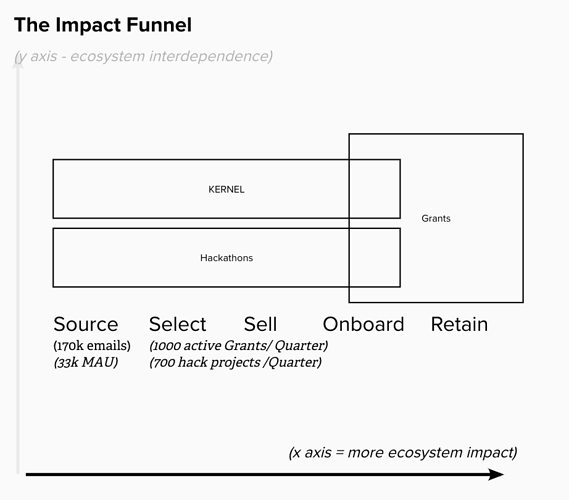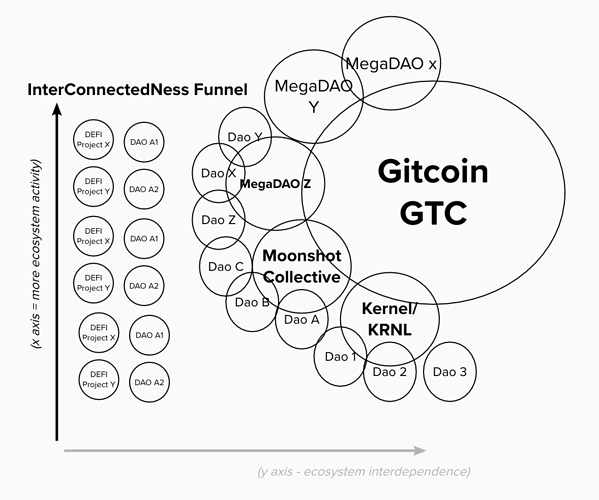Hey everyone,
On the monthly stewards call we began to discuss “What are the KPIs that GitcoinDAO Optimizes for?”.
I want to take some of my thinking on this subject from this post and use them to seed a separate discussion on this topic.
Caveat Emptor
Before reading this post, please know that these are just my opinions. I am one node in the Gitcoin DAO network.
These proposed KPIs are designed to share my sense-making, sharpen my own thinking, and to cross-pollinate ideas to/from others. Others should propose their KPIs and/or their most important thing . If you disagree with my thinking, you should fork & extend my thinking!
The 3 KPIs
As an engineer, I think a lot about optimization problems. In computer science and economics, an optimization problem is the problem of finding the best solution from all feasible solutions. It’s the process of finding a global maxima by traversing a design space.
These are the three big optimization problems I think Gitcoin/GitcoinDAO could focus on to achieve its mission.
1. Ecosystem Impact.
How much positive ecosystem impact are we having?
Basically, how many builders are we supporting? How many builders have we helped find new earning, learning, connection opportunities in the Open Internet? How many builders have quit their corporate jobs to work on open source? How many are staying in the ecosystem because they are partially or fully supported by Gitcoin?
I think of this like a funnel,
- How many developers can we source new opportunities for?
- How many can we help select an opportunity that is a fit for them?
- How can we help funding opportunities sell themselves to developers? How can we help developers sell their work to funders?
- How can we onboard them into ecosystems to produce positive impact?
- Once they are earning in these ecosystems, how can we retain them?
2. Interconnectedness
I am a big believer that It’s all coordination. That as human beings , we are interconnected and interdependent on each other for survival. How can we align our incentives better? How can we deepen our ability to coordinate? Surely if we can solve this, we can get closer to achieving our mission.
As a way of aligning incentives and truly deepening our ecosystem impact, I envision a DAO of DAOs - a mesh network of interconnected projects that all rise and fall in utility together. This DAO of DAOs would deeply interoperate with each other from a software/culture and perhaps even by swapping governance rights with each other.
3. Decentralization
I am extremely proud that when Gitcoin launched in 2017, we were focused on our core mission of economically empowering software engineers to build/fund public goods. We ignored the trend of the time, which was to write a lengthy whitepaper and do an ICO.
As a result, we have had a ton of positive impact on the world. It was an amazing feeling at EthCC to have 2 dozen hackers from across the ecosystem come up to me to shake my hand and say “hey Gitcoin had an impact on my life, awesome.”. It feels great to have helped facilitate the delivery of $26mm to OSS devs across the world.
But, the negative result of the 2017 tradeoff is that Gitcoin has some centralization debt. In the 2017-2020 market cycle we swept decentralization under the rug to focus on impact.
Given that Gitcoin has now had a positive impact, there is now actually something to govern. We want to adhere to ecosystem best practices
- Antifragility - Would Gitcoin’s impact and mission endure if Kevin got hit by a bus?
- Credible Neutrality - Are Gitcoin’s software & governance systems credibly neutral - eg are the mechanisms provably fair to all parties?
Right now the answer to these questions is no. So I believe that now it is time to pay down that decentralization debt and make Gitcoin more credibly neutral and antifragile.
That means finding practical and regulatorily compliant ways of decentralizing the governance of the network, computation of the network, development of the network, and the economics of the network.


